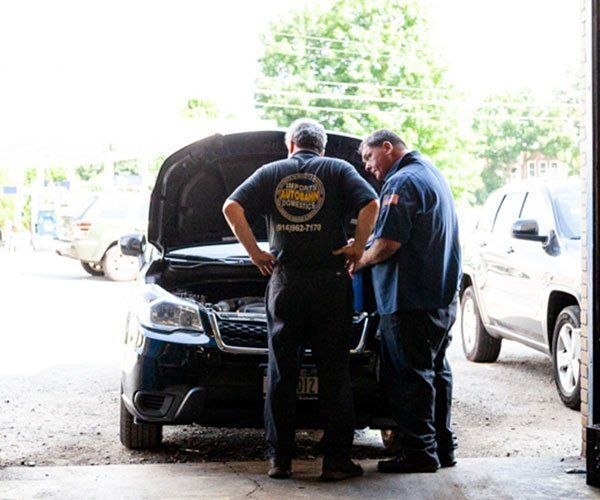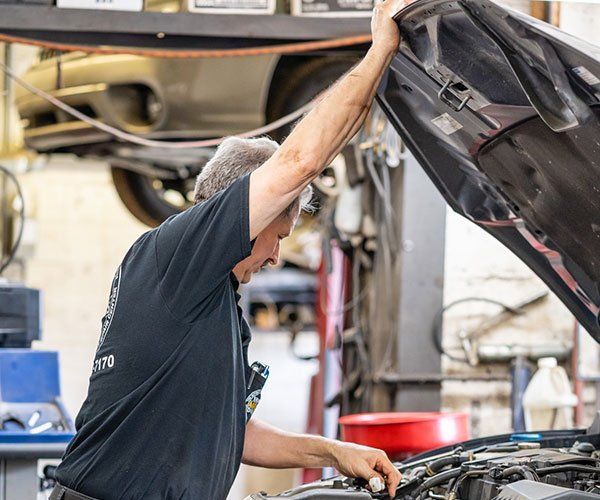Maintenance
Auto Maintenance
At Autobahn Automotive, we don’t just do repairs to get the job done. All of our work is done with extra care to prevent future issues.
Intake cleaning and Decarbonize
This is our customers' and our favorite service! Our favorite because this service pays for itself over a period of time. The pay back is better fuel economy and performance saving you money.
How does this save money?
When the engine is shut off there are still vapors in the intake manifold as well as the combustion chambers. These vapors come in contact with the many surfaces, they dry on the surfaces and form as carbon deposits. Over a period of time they build over and over, causing restrictions.
The restrictions have a negative effects on fuel injectors, valves, throttle plates, variable intake runner plates, intake ports and in combustion chambers on top of pistons, valve faces, spark plugs, cylinder heads and head gasket seal edges. This process will occur regardless of the type of fuel used.
So What is the Problem?
When the engine is cold, carbon deposits soak up fuel needed for start-up. This can lead to prolonged cranking. After the engine warms up, this fuel-soaked carbon dries and forms more carbon. This continues to rob fuel from the combustion chamber and will restrict fuel and air flow, and fuel atomization. This will diminish fuel economy and performance. It can lead to hesitation, stalling and surging. In the combustion chamber, high temperatures make This leads to over working of catalytic converters. Catalytic converters are expensive mandatory emissions devices that fails naturally, so you don’t want to add to the problem!
Carbon deposits actually start to glow and will cause pre-ignition. Pre-ignition is a condition when fuel ignites before it is supposed to. This further increases NOX, and engine knock. Today's highly computerized engines retard engine timing, reducing efficiency, compounding the problems. Head gasket materials over worked and can be weakened. This does take time to build up and could take as long as 15,000 to 40,000 miles to occur.
Brake Fluid Flush
Brake Fluid is a hydroscopic fluid, this means it absorbs moisture. The brake fluid is pumped into brake lines, hoses, abs pumps, calipers and wheel cylinders to stop our vehicles. When it is brutally cold outside, we still expect our vehicle to stop when called upon and then release the brakes when pedal is released.
So What?
Well as the brake fluid is hydroscopic this means it starts to absorb moisture naturally. Because of this, the brake fluids boiling point lowers. This can lead to brake fade and internal system corrosion. Corrosion leads to possible leaks. If the leak goes unnoticed, it will lead to brake system failure, which is a most dangerous situation. Corrosion in system can cause Master cylinders, calipers, wheel cylinders, proportioning valves, hoses, abs valving and seals to bind tear or leak. The importance of having the system flushed is to remove moisture and help stop and minimize the creation of corrosion.
Power Steering Flush
This is one of the most over-looked services, which could lead to costly repairs. This service is often over-looked because the technicians tend to treat this as a "check it out" item instead of a "possible service" item.
How Does This Break Down?
Power Steering systems generate 800 to 2000 psi of pressure. This pressure develops extreme heat when turning the steering wheel while standing still or maneuvering at low speed (for example when maneuvering in and out of parking spaces). Power steering fluid has to provide lubrication for all moving parts. It also conditions seals which are used under extreme pressure and temperature. With the extreme conditions power steering fluid has to work, such as temperature and pressure, failure is inevitable.
Oil Change
The most widely accepted service, but also the most misunderstood service. Many people think the oil should be changed either because "it's time," "it's low," or "it's dirty."
How Does this Break Down?
There is a different criterion for knowing when to change the oil. It's determined by driving conditions, that is how the vehicle is driven. Auto manufacturers take severe driving conditions into account when planning their recommendations. Severe driving conditions are frequent stopping and going, (as in city or urban driving,) short trips (as in running errands around town,) towing (as in pulling a trailer or loading the vehicle with heavy items,) or weather extremes (such as a hot summer or freezing winter) If you use your vehicle in any of the severe driving conditions listed above, then auto manufacturers will recommend more frequent intervals than the average 3,000 mile recommended the change oil intervals.
Don't forget to change the filter each time as well, as filters are also negatively affected by severe driving because the filter gets dirtier quicker with those conditions, along with more condensation and contaminates will be present. To stay on the safe side, changing the oil and filter every 3,000 miles with conventional oil and every 6,000 miles with full synthetic oil, is usually recommended by auto manufacturers.
Wheel Alignment
It is important to re-align your wheels, especially if your car is veering to the side. Wheel alignments are important to keep your steering wheel maintained.
Other Services Available:
- Engine Tune Up
- Factory Service - 30K, 60K, 90K
- Battery Service & Repair
New York State Inspection
When we say we'll keep you on the road, that also means legally! We are licensed to perform New York Automobile Inspections.
2034 Saw Mill River Rd Yorktown Heights, NY 10598
Mon, Tue, Wed & Fri: 8:00 am to 5:00 pm
Thur: 9:00 am to 5:00 pm
Sat & Sun: Closed
All Rights Reserved |Autobahn




